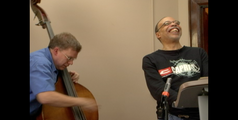Improvisation, Gender & the Body research area supports adaptive use musical instruments
ICASP's research area on Improvisation, Gender and the Body is currently supporting the work of Pauline Oliveros (Distinguished Professor of Music at Rensselaer Polytechnic Institute and ICASP Research Collaborator) on Adaptive Use Musical Instruments for the physically challenged.
Adaptive Use Musical Instruments allow people with very little physical mobility to create improvised music either by themselves or with others.
ICASP researchers will work on development and documentation of the project, and the creation of a training manual for therapists to integrate improvisation with adaptive use musical instruments. In addition to Oliveros, the team includes Linnet Fawcett, Gillian Siddall, Sherrie Tucker, Ellen Waterman, and PhD candidate Elizabeth Groeneveld.
Working in consultation with therapist Leaf Miller and programmer Zevin Polzin, the Adaptive Use team at Rensselaer has developed a computer program that allows participants to generate musical rhythms and scalar patterns through slight head movements.
Participants sitting in front of a computer screen equipped with a camera see a horizontal and vertical grid. By moving their heads slightly laterally or vertically crossing any of the four lines of the grid, they are able to access pre-programmed percussive sounds. These improvised movements enable users to create rhythmic patterns and to communicate with others musically. This technology has been successfully incorporated into the drum class led by therapist Leaf Miller of First Abilities, Inc. in Poughkeepsie, N.Y. Additionally, a virtual keyboard can be played with lateral head movement along virtual keys to create scalar melodies.


